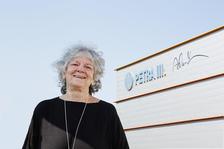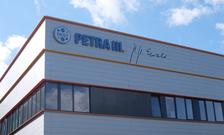Nobel laureate Ada Yonath in front of 'her' PETRA III experimental hall (Photo: DESY/Gesine Born).
The research centre DESY held a special inaugural ceremony celebrating two new experimental halls at the X-ray lightsource PETRA III which have been named after famous scientists: the Israeli Nobel laureate Ada Yonath, who conducted important research at DESY for her structural examination of ribosomes, the “protein factories” of living cells, and Paul P. Ewald, one of the pioneers of structural analysis using X-rays.
The particle accelerator PETRA III produces high-intensity and narrowly focussed beams of X-rays with which research scientists can study biomolecules or nanomaterials, for example. The two new PETRA III experimental halls will provide highly-specialised experimental stations to scientists from all over the world, and thus ideal conditions for examining materials and structures on the atomic scale and optimising them for future applications. In addition to Ada Yonath herself, who was awarded the Nobel Prize in Chemistry in 2009, and Olaf Scholz, the First Mayor of Hamburg, the event was also attended by Harsh Vardhan, India’s Minister of Research, Edelgard Bulmahn, Vice-President of Germany’s Bundestag, Georg Schütte, state secretary at the Federal Ministry for Education and Research, and Eva Gümbel from Hamburg’s Department of Science, Research and Equal Opportunities, as well as members of Ewald’s family and high-ranking visitors from Sweden and Russia.
“Ada Yonath and Paul Peter Ewald play a very special role for PETRA III,” as the Chairman of DESY’s Board of Directors, Helmut Dosch, explained. “Through his dynamical theory of X-ray diffraction, Paul P. Ewald created the foundations that are essential to type of research we are doing here. The work of Ada Yonath at DESY's lightsources contributed to the Nobel-winning decipherment of the extremely complex structure of ribosomes. Both researchers symbolise the tremendous progress that has been made in modern-day X-ray structural analysis, which researchers at the PETRA III measuring stations are now able to benefit from. So we are particularly pleased that we have been given permission to name the halls ‘Ada Yonath’ and ‘Paul P. Ewald’.“
“We are pleased that, with the new experimental halls, Hamburg has been able to satisfy the science community’s exacting expectations of a research centre,” said Olaf Scholz, the First Mayor of Hamburg. “Science needs a united Europe. Only because it was firmly integrated into the European community was Hamburg able to grow into a major, international centre of science and innovation. We are now beginning a new chapter at the Hamburg-Bahrenfeld research campus, a success story that would be unthinkable without this environment. And to come back to the reason why we are gathered here today, the family and personal life histories of the people for whom these new facilities are to be named remind us likewise of these facts.”
Three of the beamlines in PETRA III’s new experimental hall “Ada Yonath” were built in collaboration with scientists from India, Sweden and Russia. The ceremonial handover of the keys for these beamlines took place in the early afternoon alongside the inauguration ceremony for the halls themselves.
The inauguration of the two new experimental halls at PETRA III opens a new chapter in its success story: the accelerator PETRA III went into operation in 2009 as the largest and the most brilliant source of synchrotron radiation in the world. The narrowly focused X-rays are produced by directing electrons travelling at almost the speed of light through special magnets, known as undulators. Each undulator then produces high-intensity pulses of X-rays. These are fed to experimental stations where the light can then be used to address a wide range of research questions: from unravelling the structure of biological molecules, to help develop new drugs, and studying new materials and catalysts, through to examining works of art.
„At DESY, fundamental research is conducted at the highest level and in international cooperation,“ said state secretary Georg Schütte. „For the Federal Ministry for Education and Research this is an important pillar for shaping the future. Thus, the Federal Ministry supports the extension of the lightsource PETRA III with about 57 million Euros.”
The time slots available for doing research at the storage ring, which operates round the clock, are allocated by means of a strict selection procedure based on excellence. The interest among international researchers was huge, and very soon all 14 beamlines constructed in the first phase were overbooked several times over.
At the end of 2013, construction work therefore began on the two additional halls that have been inaugurated today. These halls can house up to five additional PETRA III beamlines each, expanding not only the capacity but also the range of research that can be carried out at PETRA III. Two of the beamlines have already gone into operation for research. The others will follow in early 2017.
About the individuals after whom the halls are named
At the beginning of the 20th century, Paul Peter Ewald developed his theory on the interaction between X-rays and crystals, the so-called Dynamical Theory, thereby laying an important foundation stone for the subsequent development of X-ray crystallography.
Ada Yonath received the Nobel Prize in Chemistry in 2009, together with Venkatraman Ramakrishnan and Thomas A. Steitz, for deciphering the structure and function of the ribosome. From 1986 until 2004, she was the head of the Max Planck Research Unit for Ribosomal Structure at DESY in Hamburg.
(from DESY Press Release)








